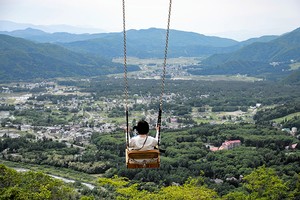By LISA VOGT/ Special to Asahi Weekly
December 19, 2023 at 07:40 JST
Sparkling, quiet, snow blanketed--is this fairyland for real? These were my thoughts upon seeing for the first time decades ago a photograph of Shirakawago on a Japanese wall calendar.
In a remote corner of Japan nestled in the pristine mountains of the Hida region in Gifu Prefecture lies a delightfully scenic settlement, where, at first glance, time seems to have stood still.
Shirakawago, together with neighboring Gokayama in Toyama Prefecture, was declared a UNESCO World Heritage site in 1995.
The hamlets are acclaimed for their “kirizuma gassho-zukuri” houses, distinctive structures that emerged between the end of the Edo Period (1603-1867) and the Taisho Era (1912-26) and continue to serve as residences.
Gassho-zukuri means construction resembling hands joined in prayer, as these farmhouse’s steeply slanted thatched roofs bear an uncanny resemblance to the clasped hands of a person engaged in solemn prayer.
I love the Japanese word "gassho," and I find it interesting that there’s not a single word in English for it. Living in the land of the rising sun, I do gassho all the time--folding my hands together to greet, request, thank, apologize, ask favors or for permission, before and after eating--gassho is a magical gesture.
Locally sourced colossal cedar pillars and beams are meticulously bound together using no nails or metal, and the buildings’ size was designed to accommodate extended families while providing efficient space for various activities. The attic space beneath the thatched roof was used for silkworm cultivation.
To reduce wind damage and make the most of the sunlight, the structures are built to face either north or south. This means gassho-zukuri houses enjoy the sun’s warmth in the winter and stay comfortably cool in the summer. How eco-conscious is that?
Incredibly, these villages remained intact, especially through Japan’s rapid economic and modernization periods.
How were they able to pull it off? First, the gift of isolation. Due to its location being one of the snowiest in the country (with an average of 10 meters of snowfall each year), the area was cut off from the outside world for months at a time every year until quite recently.
This gave rise to the concept of “yui,” a strong sense of community and commitment where locals support each other.
Second, the residents all gave their “hanko” stamp of approval, agreeing not to sell, rent, destroy or renovate the exterior of their houses, which serves to preserve and pass on the tradition and wisdom to the next generation.
A deep gassho and bow to this.
***
This article by Lisa Vogt, a Washington-born and Tokyo-based photographer, originally appeared in the Oct. 15 issue of Asahi Weekly. It is part of the series "Lisa’s UNESCO World Heritage Sites in Japan," which depicts various parts of the country through the perspective of the author, a professor at Aoyama-gakuin University.




















A peek through the music industry’s curtain at the producers who harnessed social media to help their idols go global.
A series based on diplomatic documents declassified by Japan’s Foreign Ministry
Here is a collection of first-hand accounts by “hibakusha” atomic bomb survivors.
Cooking experts, chefs and others involved in the field of food introduce their special recipes intertwined with their paths in life.
A series about Japanese-Americans and their memories of World War II